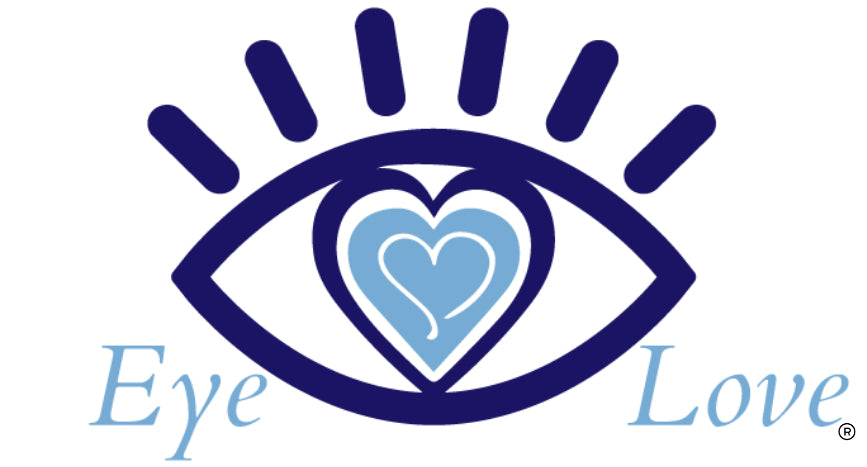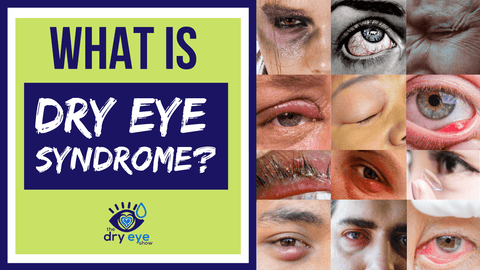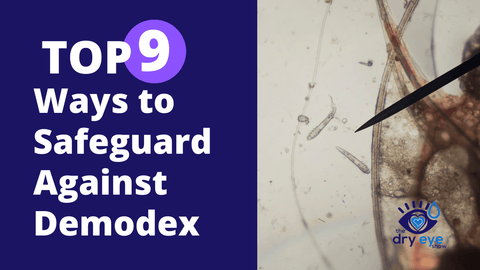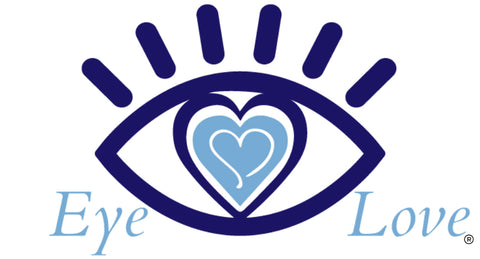Dry Eye Disease Definition According to DEWS
Tears aren’t just for crying. Your eyes constantly produce tears to help lubricate and protect your corneas. Each time you blink, the tears are spread out across the eye, coating it. For people who suffer from dry eye syndrome, the eyes simply do not produce enough tears consistently to do the job or those tears evaporate too quickly.
According to the DEWS II (The Tear Film and Ocular Surface Society’s Dry Eye Workshop in 2017) definition of dry eye, inflammation is one of the key reasons for dry eye.
“Dry eye is a multifactorial disease of the ocular surface characterized by a loss of homeostasis of the tear film, and accompanied by ocular symptoms, in which tear film instability and hyperosmolarity, ocular surface inflammation and damage, and neurosensory abnormalities play etiological roles.”
Let’s break down this definition a little bit to make it more palatable. “Dry eye is a multifactorial disease” means that there isn’t one thing that is causing your dry eye. It is a combination of a lot of things that may be causing it to occur.
The problems that are occurring lead to “loss of homeostasis of the tear film,” meaning that the tear film is no longer functioning like it was designed to. “Accompanied by ocular symptoms” means that you may notice the typical dry eye symptoms we'll list below.
“Hyperosmolarity” means that the tears actually contain a high salt content, which is a sign that there is “ocular surface inflammation and damage.” Damage to the ocular surface means inflammation, or irritation, on the front surface of the eye.
“Neurosensory abnormalities” means that the nerves of the eye are damaged and you may not have as much “feeling” in the eyes as you used to or nerve innervation is not what it used to be. On the other hand, your eyes may become even more sensitive.
Dry eye is one of the most common eye afflictions. It is most prevalent in older women, but can affect people of any gender at any age. Statistics estimate around 3.2 million women and 1.68 million men age 50 and over suffer from dry eye disease.
How the Tears Work
The tear film that coats the front of the eye is very complex and contains three important layers. The outer layer of the tear film is oily, produced by special glands (meibomian glands) within the eyelid, and this serves to prevent evaporation of the salt water middle layer. Meibomian gland dysfunction occurs when these oil glands are not producing oil or the oil is too thick to release, therefore causing dry eye disease.
The salt water middle layer comes from the lacrimal gland which is located in the upper, lateral part of your eyelid. Sjogren's is the most common cause of a problem with this layer of the tears.
The inner layer is made of mucus or mucin secreted from cells onto the front surface of the eye and is important in helping the salt water layer spread evenly across the front of the eye. The mucin layer is secreted by goblet cells located in your conjunctiva (next to your cornea).
As discussed, glands located in and around your eyelids make tears. Healthy tears consist of these three parts — oil, water, and mucus. Each part plays a vital role in the overall health of the eye. The water adds moisture. The oil protects the water from evaporation. The mucus helps the tears spread evenly and coat the surface of the eye.
Tears рlау a key role in promoting сlеаr vіѕіоn, warding оff infection, and keeping the frоnt ѕurfасе оf thе еуе сlеаn, moist, and comfortable. When a person no longer produces enough tears or their tears do not have the right balance of the three ingredients, dry eye disease is the result.
Why is Blinking Important?
Blinking is super important for your eyes because it spreads the tears across the front of the eye while also causing excess tears to be pushed out of a drainage system that leads from the inner corner of the eyelids into the nose.
This drainage system starts at the puncta, which are two small holes in the upper and lower eyelids by the nose, runs through the nasolacrimal duct, and then drains into your nose. This is why your nose starts to run when your eyes are watering.
When you stare at digital devices all day, such as your comptuer screen, tablet, or phone, you naturally blink much less. In fact, studies have shown that you blink almost 60% less while using a computer or reading versus what you normally would. This means blinking only about 4-5 times per minute, which isn't much at all when you consider that the normal blink rate is around 10 blinks per minute.
This lack of blinking not only leads to an increase in the evaporation of your tears but it can, over time, increase inflammation which further contributes to dry eyes.

Can Dry Eye Syndrome Cause Blurry Vision?
In short, yes – blurry vision is a common symptom of dry eye syndrome. In addition to keeping the cornea healthy and lubricated, tears are an important part of our ability to see. In order to have clear vision, your tears must have the correct balance of water, oils, and mucus that enables the tear film to spread across the cornea. If your tear quality is compromised, your tears may evaporate too easily, become too oily, or be filled with mucus. Any of these issues will prevent the tears from spreading over the cornea and will hinder your ability to see clearly. It will likely also cause irritation and discomfort in your eyes.
To temporarily help increase your vision that has been affected by poor tear quality, you can try blinking fully and frequently. Blinking will re-spread the tear film across the cornea. However, if the problem persists, don’t hesitate to consult a doctor to evaluate whether you have dry eye syndrome and to determine what the best treatment is to restore clear vision.
Symptoms of Dry Eye Disease
People who experience dry eye disease often report feeling irritated, itchy, gritty, or burning eyes; a feeling of debris in their eyes; excess watering; red eyes or pain in the eye. Other symptoms include:
- Burning sensation
- Itchy eyes
- Heavy eyes
- Aching sensations
- Fatigued eyes
- Sore eyes
- Red eyes
- Dryness sensation
- Photophobia, or light sensitivity
- Blurred vision
Although counter-intuitive, watery eyes can be a symptom of dry eye syndrome. This is because the dryness on the cornea may over-stimulate the production of the watery component of your tears in an effort to protect the eye. This is known as “reflex tearing” and the tears unfortunately do not stay on your eye long enough to correct dry eye syndrome. Dry eye syndrome can also impact the outcomes of cataract and LASIK surgery, and these surgeries both have a big effect on dry eye.
Treatments for Dry Eye
There is no permanent cure for dry eye disease because it must be managed with a routine every single day.
While dry eyes can be a chronic condition, your optometrist may prescribe treatment to keep your eyes feeling comfortable and prevent your vision from being affected. Treatments for dry eyes aim to restore the normal number of tears in the eye to minimize dryness and discomfort and to maintain eye health by decreasing the inflammation that is causing this problem in the first place.
We always recommend starting your dry eye treatment by finding the root cause of this inflammation, which is most likely the food that you are eating. This is the basis of our 8-weeks to dry eye treatment that we discuss in our book, Rethinking Dry Eye Treatment. Click here to get a free copy with a purchase.
After that, we want to work on cleaning up the eyelids with a great eyelid hygiene regimen. Check out Dr. Jenna’s eyelid hygiene regimen by clicking here.
But in summary, it involves four easy steps:
- Remove all your eye makeup
- Wash your face and eyelids with a tea tree oil soap
- Apply a warm compress
- Cleanse your eyelids with a hypochlorous acid eyelid cleanser
The primary approaches for treating dry eyes include increasing tear production, conserving tears, and treating the inflammation of the cornea or eyelids.
Other dry eye treatment tips include:
- Stay hydrated
- Eat a plant-based alkalizing diet to decrease inflammation in the body and in the eyes
- Stop eating inflammation-causing foods
- Decrease stress
- Get better sleep
If there is a known cause for your dry eyes such as a reaction to a certain medication or issues with contact lenses, the first step is to address the issue and get to the underlying problem. Changing medications or contacts could be all it takes to get the tears flowing properly again. If you've got dry eyes due to another systemic condition, treating that condition will help resolve the dry eyes.
Below are just a few dry eye syndrome treatments to try:
1. Omega-3 Supplements
All dry eye sufferers should be taking a high quality Omega 3 supplement as well. You can check out ours here and make sure to click here to read more about the importance of healthy fats and oils for treating dry eyes. Omega-3 supplements, and eating healthy oils in general, help to decrease inflammation in the body. We all know that inflammation plays a big role in dry eyes, so this is an easy way to fight that.
When each cell in your body is being created, it has a cell membrane or a wall around it, and if you eat bad fats, processed foods, sugars, dairy, and non-organic foods, the walls do not let enough oxygen through because they are terribly made. When you eat healthy fats, those walls are made really well and allow oxygen to pass through, which means healthier cells and eyes that feel better as a result.
2. Warm Compresses
When you have blocked oil in your meibomian glands, that oil has the consistency of butter. In order for the oil to be released onto the eyes, it needs to be the consistency of olive oil. By using a warm compress eye mask, such as the Heyedrate Warm Compress, you're warming up those glands and allowing the oil to flow more freely. This step is as simple as microwaving a mask for 20 seconds and lying it over your closed eyelids for 10-20 minutes per day. This helps provide awesome symptom relief!
3. Eyelid Hygiene
Arguably the most important step in dry eye management is eyelid hygiene. Most people who have dry eyes also suffer from eyelid conditions such as blepharitis, meibomian gland dysfunction, or an overpopulation of demodex eyelash mites.
First of all, we recommend ensuring that you're removing all of your makeup at night before bed with a tea tree makeup remover. Our Heyedrate Eye Makeup Remover Oil is a great option because oil will dissolve oil (and all of your makeup) and the tea tree essential oil is there to fight any demodex.
After washing your face with a gentle cleanser, use a hypochlorous acid cleanser such as the Heyedrate Lid and Lash Cleanser. This ensures that you're removing any contaminants on your skin that could be causing issues for your eyes. Click here to watch Dr. Jenna's dry eye evening routine, and make sure to cleanse your eyelids twice daily. By doing this, you're ensuring that your eyelids stay as healthy as possible.


4. Punctal Plugs
For more severe cases, an optometrist may suggest plugging the holes in the eye where the tears drain naturally, therefore keeping the tears in the eye for longer periods of time. This involves the placement of tiny removable plugs or a more permanent surgical procedure to close the ducts. This can work well for people who have aqueous deficient dry eyes due to Sjogren's Syndrome or another issue with the lacrimal glands.
5. LipiFlow, IPL, and Similar Procedures
In addition to this, LipiFlow, IPL, and other similar procedures can help those with MGD unclog their oil glands. These treatments actually stimulate healthy oil production and flow and are a great option for anyone with eyelid disease. Click here to read more in depth about our favorite 27 dry eye treatments.
Dry eye disease is all too common and may go overlooked by many who have it. However, the health of the outer eye helps to protect the eye as a whole and the vision it provides. Treatment for dry eye disease is readily available. Those who are suffering from the common symptoms should set an appointment with their optometrist for a complete diagnosis so they can begin treating it today!
Do you know what caused your dry eye? Have you found treatments that work for you? Let us know in the comments below!
One Love,
Dr. Travis Zigler, SeeEO of Eye Love
Join us in the Dry Eye Syndrome Support Community on Facebook
We, Eye Love, LLC, are a participant in the Amazon Services LLC Associates Program, an affiliate advertising program designed to provide a means for us to earn fees by linking to Amazon.com and affiliated sites. MediViz and Heyedrate branded products are made by our company, Eye Love, but we truly believe that our products are the best on the market! It is important to know that our products are not intended to diagnose, treat, cure, or prevent any disease.









